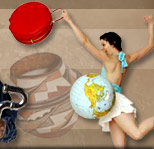Continued from page 1
Be sure you have ability to get reprints should you damage one of your photos. Accidents do happen. Scan your original to a digital file if you don’t have a negative or digital camera file. Have any valuable old photos professionally copied. There are two reasons for this: newer papers and newer inks both add durability.
ability to get reprints should you damage one of your photos. Accidents do happen. Scan your original to a digital file if you don’t have a negative or digital camera file. Have any valuable old photos professionally copied. There are two reasons for this: newer papers and newer inks both add durability.
Plan your journaling: what title and other words can you use to tie photos together? Take your time with this step. Let your concept evolve and take shape. Think about your audience and especially
photos together? Take your time with this step. Let your concept evolve and take shape. Think about your audience and especially person or people in
person or people in photos. What will evoke a smile or wonderful memory for them?
photos. What will evoke a smile or wonderful memory for them?
Diagram a few scrapbooking layouts with your photos to settle on a balanced composition and to give you an idea of how much other “real estate” you have to play with. Your diagram will include some or all of following: background paper; slashes or splotches of other papers; text box(es); a title box; and your photos.
following: background paper; slashes or splotches of other papers; text box(es); a title box; and your photos.
Next consider what additional elements and techniques you will use to decorate: stamping; embossing; buttons; brads; ribbons; rub-ons; tags in paper or even glass or metal; twill tape; envelopes; and tiny embellishments.
“Tiny embellishments” is a whole industry that was practically launched by scrapbook art. If you remember being enthralled by doll house furniture and accessories as a child, you will be both enchanted and taken back to one of childhood’s joys by scrapbooking embellishments.
Your shopping list is almost complete and should look something like this.
1. Background paper(s): size and color(s). Be sure any paper that will touch your photos is acid-free (archival quality). 2. Accent paper(s). Album, D-ring binder or frame and perhaps page protectors or glass. Ditto on “acid-free”. 3. Letters: your choice of rub-ons, stamps, metal glue-on letters, stickers, die-cut letters, old fashioned “typewriter key” letters. [You can also create some text using computer graphic or word processing programs.] 4. Ideas for embellishments.
Just brainstorm and jot down some items, but allow yourself to be inspired by what you find.
Last, but not least, don’t forget basics (some of which you may already have on hand). 5. Adhesives – from glue sticks and dots to tape and two-sided tape. Be sure those that will touch your photos are acid-free. 6. Cutting tool(s): good quality scissors and perhaps a paper trimmer. 7. Black journaling pen if you plan to write or draw in your own hand.
basics (some of which you may already have on hand). 5. Adhesives – from glue sticks and dots to tape and two-sided tape. Be sure those that will touch your photos are acid-free. 6. Cutting tool(s): good quality scissors and perhaps a paper trimmer. 7. Black journaling pen if you plan to write or draw in your own hand.
The rest is easy. So enjoy!
By: Eileen Bergen The Artful Crafter http://www.theartfulcrafter.com/scrapbooking-two.html

Ms Bergen has had a varied career, first as a special education teacher and then, after getting a MBA degree, as a vice-president of a major insurance firm. She has been making and selling crafts for the past eight years.



